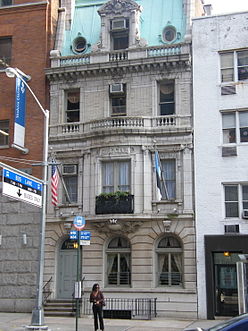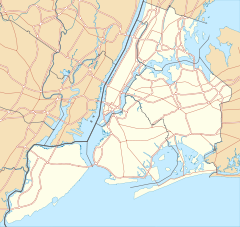- New York Estonian House
-
New York Estonian House 
243 E34th StFormer names Civic Club building Alternative names New Yorgi Eesti Maja (Estonian) General information Type Clubhouse Architectural style Beaux-Arts Location 243 34th Street
New York, New York 10116
 United States
United StatesAddress 243 East 34th Street Coordinates 40°44′42.5″N 73°58′34.25″W / 40.745139°N 73.9761806°WCoordinates: 40°44′42.5″N 73°58′34.25″W / 40.745139°N 73.9761806°W Construction started 1898 Completed 1899 Renovated 1946–1947, 1992 Technical details Floor count 3 Design and construction Owner The New York Estonian Educational Society Architect Thomas A. Gray New York Estonian HouseLocation: 243 East 34th Street, New York, New York Coordinates: 40°44′41″N 73°58′34″W / 40.74472°N 73.97611°W Area: less than one acre Built: 1898 Architect: Thomas A. Gray Architectural style: Beaux Arts Governing body: Private NRHP Reference#: 82003372[1] Added to NRHP: September 16, 1982 The New York Estonian House (Estonian: New Yorgi Eesti Maja) is a 3-story Beaux-Arts building located at 243 East 34th Street in the Kips Bay neighborhood in the New York City borough of Manhattan. The building was designated as a landmark by the New York City Landmarks Preservation Commission in 1978.
The house was originally built for the Civic Club in 1898–1899, having been designed by Brooklyn architect Thomas A. Gray. The Civic Club was founded by the local social reformer F. Norton Goddard (1861–1905) to reduce poverty and fight against gambling in the neighborhood. After Goddard’s death in 1905 the club ceased to exist, but the building remained in the Goddard family until 1946, when Frederick Norton’s widow sold it for $25,000 to The New York Estonian Educational Society, Inc., which is still the owner of the house today. The building underwent a $100,000 restoration in 1992.[2][3]
Known as the Estonian House (Eesti Maja), the building houses a number of Estonian organizations such as the New York Estonian School (New Yorgi Eesti Kool), choruses for men and women and a folk dancing group.[3] Vaba Eesti Sõna, the largest Estonian-language newspaper in the United States is also published at the New York Estonian House.[4][5] The Estonian House has become the main center of Estonian culture on the U.S. Eastern seaboard, especially amongst Estonian-Americans.
See also
- Estonian-Americans
- List of Estonian Americans
- Estonia – United States relations
- Estonian House
- National Register of Historic Places listings in Manhattan from 14th to 59th Streets
- Estonian Consulate General in New York
References
- ^ "National Register Information System". National Register of Historic Places. National Park Service. 2009-03-13. http://nrhp.focus.nps.gov/natreg/docs/All_Data.html.
- ^ "Estonian House; Beaux-Arts Restoration". New York Times. 1992-05-17. http://www.nytimes.com/1992/05/17/realestate/postings-estonian-house-beaux-arts-restoration.html. Retrieved 2009-09-05.
- ^ a b "Estonian House History, Board of Directors and Organizations". New York Estonian House. http://www.estonianhousenewyork.com/eng_eesti_maja.html. Retrieved 2009-09-05.
- ^ Goodnough, Abby (1994-11-06). "Making it Work; Cold War Without End". New York Times. http://www.nytimes.com/1994/11/06/nyregion/making-it-work-cold-war-without-end.html. Retrieved 2009-09-05.
- ^ "Estonia and the US". Estonian Consulate General in New York City. http://www.nyc.estemb.org/estonia_and_the_us. Retrieved 2009-09-05.
External links
- Official website
- New York Estonian House on Facebook
- Estonian House described by Landmarks Preservation Commission in 1978
- Images of the building in New York Architecture Images
Categories:- Buildings and structures in Manhattan
- Beaux-Arts architecture in New York
- Estonian diaspora
- Clubhouses on the National Register of Historic Places in Manhattan
- Houses completed in 1899
- Estonia–United States relations
Wikimedia Foundation. 2010.



